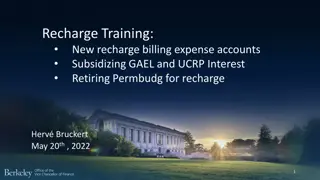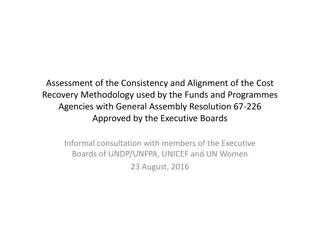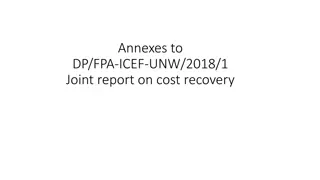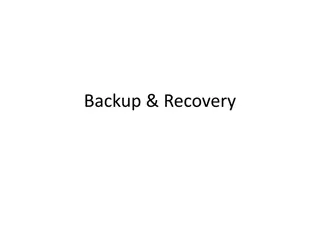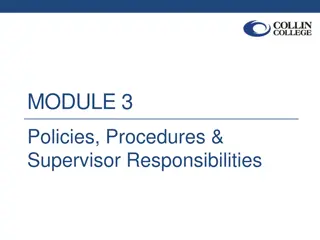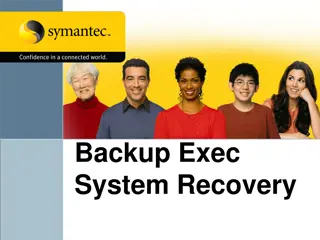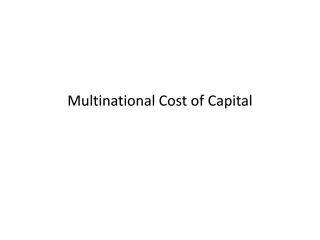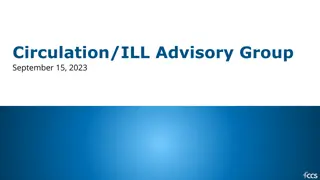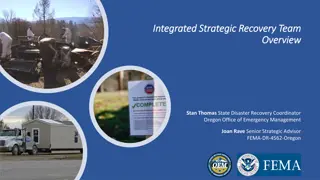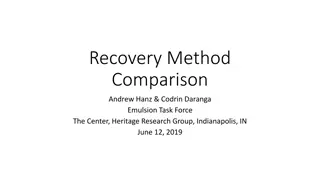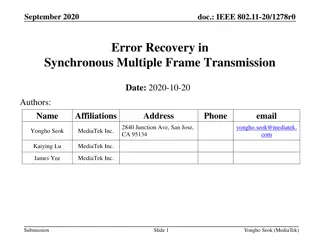Understanding Recharge Policies and Procedures for Cost Recovery
Explore the guidelines and processes related to recharge activities, including developing rates, monitoring, and closing operations. Discover the significance of recharge centers in recovering costs and supporting the academic mission. Learn about direct and indirect expenses in sponsored projects and how recharge rates are established.
Download Presentation

Please find below an Image/Link to download the presentation.
The content on the website is provided AS IS for your information and personal use only. It may not be sold, licensed, or shared on other websites without obtaining consent from the author. Download presentation by click this link. If you encounter any issues during the download, it is possible that the publisher has removed the file from their server.
E N D
Presentation Transcript
Recharge Policies & Procedures Recharge Policies & Procedures Herv Bruckert January 11th, 2018 1
Agenda Framing recharge activities What is a Recharge Center? Functional Responsibilities How to Develop a Recharge Rate Billing for Recharge Goods or Services Surpluses and Deficits Self Monitoring Self-Certification Close/Shutdown a Recharge Operation Common Issues References and Contact Information Recharge Form 1. 2. 3. 4. 5. 6. 7. 8. 9. 10. 11. 12. 2
Framing Recharge activities: Why recharge? UC Berkeley Admin Recharge Unit B Academic Recharge Unit A Affiliates, including other UC campus External Clients Research Recharge Unit C Research Recharge Unit D Sponsored Projects Contract & Grants 3
Framing Recharge activities: Why recharge? Sponsored projects policies require that expenses be broken down between: Direct expenses Indirect expenses (Facilities & Administration F&A) Direct expenses are directly charged to C&G. Indirect expenses are charged to C&G by multiplying Direct expenses by an F&A rate. Recharge rates are established based on direct expenses and provide a mechanism to allocate costs to C&G enabling the University to be reimbursed for the C&G activities it conducts. 4
Topic 1. 2. 3. 4. What is a RechargeCenter? What is a recharge center? Common Issues References, Forms and Contact Information 5
What is a Recharge Center? Rules and Criteria Unit providing specific goods or services to a number of campus departments on an ongoing basis. The unit is allowed to recoverits costs in providingthose goods or services through a chargeto its users. Some rechargecenters may generate revenues fromincidental sales or servicesto individualsor off-campus entities. Services provided should not be readily available from outside sources (Or if they are, there must be overriding economic or ethical issues requiring the University to provide these services). Services can be provided to non-campus, non-affiliate entities only if they are unique and support the campus s academic mission or are not in competition with commercial sources rates should be fully costed and include a surcharge to recover campus indirect costs. 6
What is a Recharge Center? Rules and Criteria Activity charged to C&G Yes All recharge activity on campus is expected to comply with the University's recharge policy. If a recharge activity charges contract & grants for any amount, the unit is expected to submit an annual self-certification for divisional and recharge committee review. If a recharge activity does not charge contracts & grants but charges more than $200K per year, the unit is expected to submit an annual self-certification for divisional and recharge committee review. If a recharge activity charges less than $200K per year and does not charge contracts & grants, the unit does not need to submit an annual self- certification for divisional and recharge committee review. No Yes Recharge income > $200k per year No No need to self certify Self Certify 7
What is a Recharge Center? Rules and Criteria All campus users are charged the same rate for the same services performed or goods provided. Rates to affiliates can include a surcharge up to the ICR rate to cover any indirect cost. Recharge centers must only charge their published, authorized rates. Separate costs and budgets must be clearly defined for recharge activities Units should operate at close to break even. To ensure that the services are necessary and are the best use of departmental/University resources, units should evaluate their services on a regular basis, at least annually. Your control unit is your primary contact for assistance in this area. 8
What is a Recharge Center? Rules and Criteria All recharge activities are expected to comply with recharge policy. However, only recharge activities charged to C&G or with annual income >$200,000: are required to self certifyonce a year as part of the budget process have ratesthat arepostedto the rechargeweb site submit requests for in year rate changes as their businessneeds demand, subjectto control unit and central review. 9
What is a Recharge Center? Issues to Consider when evaluating setting up a recharge center Why do we want to conduct this recharge activity? Should we be in this business? Do we have the expertise to provide this service? What are the risks and how will we manage them (e.g. product/service liability, workers comp, etc.)? Do we have the time to manage/monitor this activity? 10
What is a Recharge Center? Issues to Consider when evaluating setting up a recharge center Is this service covered by our existing budget (e.g. 19900, 69750 fund sources etc.)? How will we determine rates? Who are our customers? How will we budget for this activity? Will we breakeven? How will we cover an unforeseen loss? How will we monitor the financial status? 11
What is a Recharge Center? Issues to Consider when evaluating setting up a recharge center How will we bill? How will we monitor the receivables? How will we handle cash receipts: cash, checks, credit cards etc.? How will we prepare the recharge journals? How will we handle sales tax issues? How will we report unrelated business income tax (UBIT)? Do we have adequate insurance coverage? 12
What is a Recharge Center? Examples of Recharge Activities Nanolab Services Chemical Waste Disposal Electron Microscope Facility Mail Services Animal Care IT and Facilities Services* *Some of the IST and FS services might shift to a common goods assessment model instead of the current recharge model. 13
What is a Recharge Center? Examples of Non-recharge Activities Customary services within general administration Central Accounting, Human Resources, Budgeting. Two departments share the costs of a machine equally. General, non-identifiable services general administration fee. Auxiliary Services: service to individuals parking, residential and student services. 14
What is a Recharge Center? Auxiliaries Provides servicesto students, faculty or staff. Auxiliaries are considered to be self supporting & provide non- instructional support, but not all self supporting units are auxiliaries. Some Auxiliaries: Residential and Student Service Programs Rec Sports Intercollegiate Athletics Parking and Transportation 15
Topic 1. 3. 4. 5. What is a RechargeCenter? Functional Responsibilities Common Issues References, Forms and Contact Information 16
Functional Responsibilities Role of the Department Overall operation of recharge centers. Assures compliance with current University recharge policy. Reviews services provided on an ongoing basis. Reviews budget, revenue and expenditures on an ongoing basis. Reviews rates as business needs change to assure unit s balances remain within tolerance. Submit annual self certification form as part of the yearly budget process. 17
Functional Responsibilities Role of the Control Unit (Division) Oversees and assists with operation of recharge units. Approves all recharge rate changes and annual self certification forms prior to submission to the recharge committee. Reviews services provided by the recharge centers periodically. Assures all units within the control unit submit an annual self certification form. 18
Functional Responsibilities Role of the Recharge Committee Acts in an advisory capacity to recharge centers and campus departments. Acts in an advisory capacity for developing University recharge policy and procedure. Approves the establishment of all new recharge centers. Reviews all surplus or deficit reduction plans and monitors a unit s progress toward reduction goals. Approves all in year recharge rates changes and all recharge rates submitted as part of the yearly budget process. 19
Functional Responsibilities Role of the Office of the VC Finance and CFO Provides general accounting assistance to the recharge centers. Provides training to the campus community. Provides binding mediation on all recharge disputes between recharge centers and their customers. Provides ongoing fiscal review of the University s recharge operations. Consolidates yearly rate change request for review and approval by the Recharge Committee. Presents in year rate change request for review and approval by the Recharge Committee. 20
Topic 1. 4. 5. What is a Recharge How to Develop a Recharge Rate Billing for Recharge Goods or Common Issues References, Forms and Contact Information 6. 21
How to Develop a Recharge Rate Steps to Rate Development Identify costs along lines of business Identify lines of business Identify methodology to allocate costs Develop rates Estimate Revenues and Volumes Self Certify Templates for rate development can be found on the recharge web site: https://cfo.berkeley.edu/recharge Templatesfor rate development can be foundonthe rechargewebsite: https://cfo.berkeley.edu/recharge 22
How to Develop a Recharge Rate Basic Formula Basic Rate Formula: Estimated Cost of Providing Goods or Service* Recharge Rate = Estimated Number of Service Units to be Provided *Costs may need to be adjusted to include allowable surpluses and deficits from prior years and subsidies 23
How to Develop a Recharge Rate Rate Development Different services offered within the same unit or department may have separate recharge rates (Separate rates for each class of goods or services). Identical goods and services must carry identical prices for any and all campus customers. Units may charge only the rates posted on the campus recharge website: https://cfo.berkeley.edu/recharge 24
How to Develop a Recharge Rate Cost Pool Development Include all direct costs Costs must be allowable. Costs need to be reasonable, i.e. generallyrecognizedas necessaryfor the operation. Costs must be treatedconsistently i.e.directv. indirect.Cost are identifiable to the rechargeunit. Cost are reasonablyallocable. Whenallocatinga cost to a rechargeunit, we must be able to assign the cost, or a groupof costs, to the recharge pool in reasonable andrealistic proportionthat demonstrates the benefitprovided. 25
How to Develop a Recharge Rate Allowable Costs Identify costs to be included in cost pool. Allowable costs normally include but are not limited to: Salaries, Wages and Fringe Benefits Supplies and Services Costs of Leased Non-Capital Equipment/Facilities Equipment Depreciation Repairs and Maintenance Prior Year Operating Surplus/Loss that occurred through the normal course of business 26
How to Develop a Recharge Rate Unallowable Costs Costs of capitalized renovations or leasehold improvements Contingency Reserves Cost Paid by Federal Government Alumni Activities Entertainment (Alcohol, event tickets, flowers, gifts, etc.) Donations/Contributions Memberships/Civic/Community/ Social Org. Abnormal (non-operating) deficits a) h) i) b) Internal Interest Expense Bad Debts c) j) d) Fines/Penalties k) e) Inventorial/Capital Equipment Purchases Commencement/Convocation Costs l) f) m) Fund Raising Expense g) n) 27
How to Develop a Recharge Rate Equipment Depreciation Capital equipment with useful life > 1 year and value > $5,000 shall be depreciated on a straight line basis. Recommended useful life tables can be found at the following link of the UCOP website: https://eulid.ucop.edu/index.php Depreciation expense is included as a cost in the rate development, except when: Equipment is funded by the federal government, Equipment is funded by an incomplete, private contract or grant, Equipment is identified as cost sharing to a federal research project. 28
How to Develop a Recharge Rate Reserve Funds Through depreciation journal entries,a reserve fund is established. Please refer to the recharge policy for sample of depreciation journal entries Equipmentreserve funds should be usedto purchase replacement equipmentneededfor the rechargeoperation. Exceptions are subject to the Recharge Committee approval. A decommissionedrecharge unit can use its equipment reserve funds to off set any recharge operationaldeficit. Residual reserve funds may be retainedby the department subject to the Recharge Committee approval. 29
How to Develop a Recharge Rate Subsidies Subsidies fund a portion of the recharge unit s total costs which result in lower recharge rates. Subsidies included in rates reducethe pricefor allcampus users of specific products or services producedby the recharge. Non-campus users must be chargedthe unsubsidized rates plus a minimum surcharge based on the current ICR rates. 30
How to Develop a Recharge Rate Surcharges In addition to charging fully costed rates, units must assess a minimum additional charge to non-campus customers intended to recover campus indirect costs (ICR). The minimum surcharge is the ICR rate. Affiliates and auxiliaries are campus customers. Affiliates, however, can be assessed a surchargeup to the current campus ICR rate. Exceptions to charging a surcharge at the full ICR rate for external customers are subject to the Recharge Committee approval. 31
How to Develop a Recharge Rate Surcharges Surcharge funds generated are recorded to a separate fund and are retained by the generating department to be used at the unit s discretion, generally to defray administrative costs. Coding to a separate fundand account ensures that the balance of the recharge operations fund is not distortedby surchargeincome. For recharge units, the administrative full costing (AFC) assessment will be postedto the surchargefund. 32
How to Develop a Recharge Rate Surcharges For Educational Activities, code surcharge income to revenue account 46XXX and fund 60050. For all other activities, code surcharge income using revenue account 48XXX and fund 66350. 33
How to Develop a Recharge Rate Recharge Rate Change Procedure Units may charge only the rates posted on the campus recharge website To revise rates,fill out and submit self certification form plus a list of rates to the recharge portfolio lead. 34
Topic 1. 5. Billing for Recharge Goods or Services 6. Surpluses and Deficits 7. Self Monitoring 8. Self Certification 9. Close/Shutdown a Recharge Common Issues 10. References, Forms and Contact Information What is a Recharge 35
Billing for Recharge Goods or Services Timely Billing A recharge center must bill their customers in a timely manner. Within60 days after the goods or services have been delivered or the projectis complete; or Within60 days after the recharge center has been billedby a third partyprovidingthe goods or services. A revenue center should bill their customers in a timely manner to minimize the risk of non-payment. Best practice is to bill in advance. If the billing schedule cannot be met, immediately contact your customers to negotiate a new schedule. If a mutually agreeable schedule cannot be met, the recharge center must contact the recharge lead for mediation. 36
Billing for Recharge Goods or Services Posting to the General Ledger A recharge customer has 60 days from the time a recharge is posted to the general ledger to dispute the charge. 37
Billing for Recharge Goods or Services Uncollectible Recharges Uncollectible recharges are unallowable costs. Recharge units must identify a non-recharge chartstring to which these costs are charged. Recharge units may not include these costs in future rate developments. 38
Billing for Recharge Goods or Services Statement Format and Content Invoices for recharge goods or services must contain the following information: (see policy document for complete list): Full chartstring charged Description of goods/services provided Date of service Amount charged 39
Billing for Recharge Goods or Services Records Retention Because recharge centers are subject to periodic review and their charges are subject to audit, each recharge center must retain the following records: Founding documentation:5 years after the unit is decommissioned Rate development detail: 5 years Recharge billing supporting documentation: 5 years Recharge center operatingcosts-see UC retention guidelines: http://www.policies.uci.edu/adm/records/721-11a.html 40
Topic 1. 6. 7. 8. 9. Responsibilities Surpluses and Deficits Self Monitoring Self Certification Close/Shutdown a Recharge Common Issues 10. References, Forms and Contact Information 41
Surpluses and Deficits Recharge Operations Must Break-even Break-even occurs when costs of products or services is equal to the recharge income received from customers. A recharge center is expected to operate close to break-even over a period of time and be within the recharge tolerance for its rates. Monitoring operating revenues, expenditures and fund balances is the usual method for determining break-even compliance. 42
Surpluses and Deficits Definition of a Large Surplus/Deficit A large surplus/deficit defined as: recharge fund balance > 1 month operating expense (rolling 12 month average expenses). If a unit needs to maintain a balance > 1 month operating expense for day- to-day operations, it can seek approval from the recharge committee through the control unit. 43
Surpluses and Deficits Deficits Unit must develop deficit reduction plan to eliminate out-of-tolerance deficits as soon as possible. Reduction period should not exceed 1 year. Deficits outside of tolerance or outside of any approved deficit reduction plan at fiscal year s end will be subject to the terms of the campus deficit resolution policy. 44
Surpluses and Deficits Surpluses Unit cannot raise rates without a detailed review. Unit must submit reduction plan to eliminate surplus within 3 months notification of out-of-tolerance status. Surplus reductionplans are submitted to the recharge lead. Plan should eliminate surplus as soon as possible to be within tolerance by fiscal year end. Surpluses cannot be transferred to reserve funds. 45
Topic Functional and Deficits 7. Self Monitoring 8. Self Certification 9. Close/Shutdown a Recharge Common Issues 10. References, Forms and Contact Information 46
Self Monitoring The recharge unit should monitor its recharge activity on a monthly basis or at a minimum on a quarterly basis. Forecast should be updated to reflect the latest thinking for the balance of the year regarding recharge activities. Units can use BAIRS reports and smartview reports, including the smartview report captured in the self-certification file to monitor recharge activities. 47
Topic 8. 9. Self Certification Close/Shutdown a Recharge Common Issues 10. References, Forms and Contact Information 48
Self Certification When to Self Certify In Jan- Feb of each year as part of the yearly recharge budget process To establish a new recharge center To establish new services in an existing recharge center To change rates for existing services To apply new costing methodologies to existing rates 49
Self Certification Control Unit reviews self cert Unit Completed self cert is forwardedto controlunit completes self cert form Disapproved self certs Office of VC Finance reviews self cert Approved self certs Disapprovedself certs Office of VC Finance posts rates to recharge website Recharge Committee review and approve rates 50





